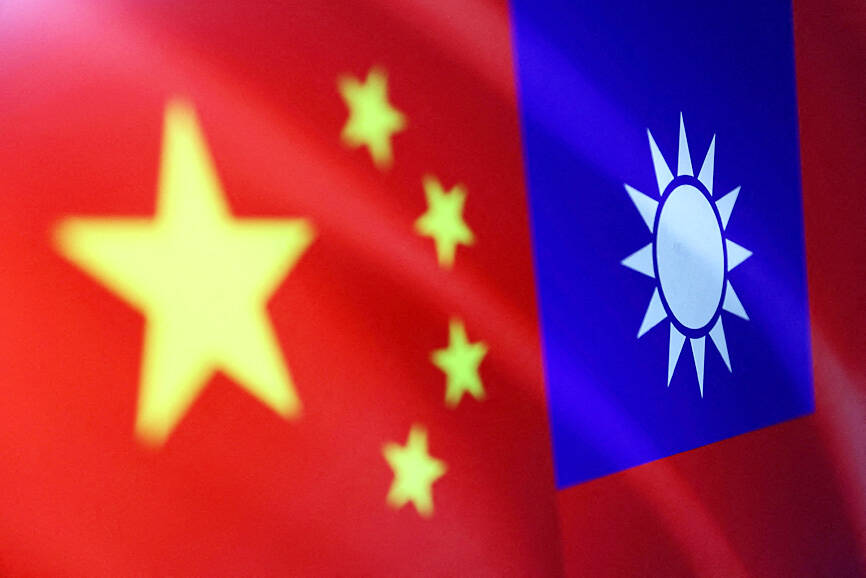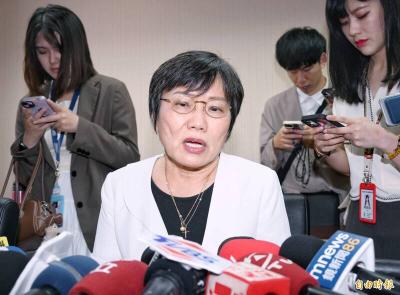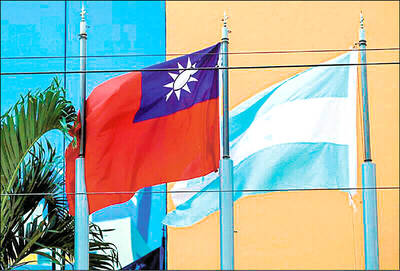Anchored in the heart of colonial San Salvador, a towering and expansive library was this week inaugurated by Salvadoran President Nayib Bukele, the latest sign of China’s growing influence across Central America.
With the Chinese ambassador at his side, Bukele toured the seven-story building, erected at a cost of US$54 million paid for by China.
The building sprawls over 2.4 hectares, and contains gamer and robotics areas, interactive digital screens, and a digital library and shelves containing 360,000 books, the government said on Tuesday last week.

Photo: Reuters
A day later, the son of Nicaraguan President Daniel Ortega, Laureano Ortega, inspected 250 Chinese-made buses and thanked Beijing for the “special relationship” he asserted was lifting the nation out of poverty.
“The new politics of the region has accelerated China’s influence and put distance between the US and Central America, from the leftist authoritarian Ortega regime to the right-wing authoritarian Bukele regime,” said Evan Ellis, a researcher at the US Army War College’s Strategic Studies Institute.
Since Costa Rica switched diplomatic relations from Taipei to Beijing in 2007, China has steadily gained ground in Central America, establishing relations with Panama (2017), El Salvador (2018), Nicaragua (2021) and most recently Honduras earlier this year.
“China’s efforts in Central America have mostly been driven by an interest in isolating Taiwan,” said Margaret Myers, a specialist in China and Latin America at the Inter-American Dialogue think tank.
In Central America, only Guatemala and Belize are among Taiwan’s 13 diplomatic allies.
“Central America is part of this isolation effort,” Salvadoran economist Cesar Villalona said.
Nicaragua on Thursday ratified a free-trade agreement with China, while El Salvador and Honduras are pursuing their own trade accords with Beijing.
However, commercial trade ties are heavily tilted in China’s favor.
In Costa Rica, for example, imports from China have reached US$3.35 billion, while its annual exports total only US$400 million, and El Salvador imports US$2.8 billion while exporting US$48 million, official trade figures showed.
“China is very far. Our productive capacity is poor and shipping costs and insurance rates make it hard to compete on cost. In Nicaragua, the deficit will grow” with the free-trade pact, said Enrique Saenz, a Nicaraguan economist living in exile in Costa Rica.
Although these economies are not important to China, they are along key trade routes.
Panama, crucial due to its cross-isthmus canal, has had Chinese companies involved in the construction of maritime terminals on the waterway, of which China is the world’s second largest client, after the US.
China’s largest banks have a presence in Panama’s financial center and dozens of Chinese companies offer goods in the Colon Free Zone (at the Caribbean terminus of the canal), former Panamanian vice minister of foreign affairs Luis Miguel Hincapie said.
Myers said that Central American countries “represent a notable market for Chinese tech exporters.”
Laureano Ortega, in whose country Chinese companies are planning road, airport and energy projects, spoke of a 5G technology plan after recently visiting the Shenzhen headquarters of telecommunications giant Huawei.
In addition to the library, China is to build a 50,000-seat soccer stadium in El Salvador, larger than the one it built in Costa Rica, as well as a shipping wharf on the Pacific coast, all at little or no cost.
Earlier this month, US President Joe Biden warned Costa Rica’s president and several other Latin American leaders gathered in Washington not to fall into a “debt trap” — a veiled reference to China.
“The trap is already in place,” Honduran Minister of the Presidency Rodolfo Pastor said, referring to his country’s huge debt with organizations and foreign banks.
Pastor said the relationship with the US over the past 40 years has not helped the region to “get out of poverty or trigger development.”
“We have to bet on something new,” Pastor said.

Chinese Nationalist Party (KMT) Chairman Eric Chu (朱立倫), spokeswoman Yang Chih-yu (楊智伃) and Legislator Hsieh Lung-chieh (謝龍介) would be summoned by police for questioning for leading an illegal assembly on Thursday evening last week, Minister of the Interior Liu Shyh-fang (劉世芳) said today. The three KMT officials led an assembly outside the Taipei City Prosecutors’ Office, a restricted area where public assembly is not allowed, protesting the questioning of several KMT staff and searches of KMT headquarters and offices in a recall petition forgery case. Chu, Yang and Hsieh are all suspected of contravening the Assembly and Parade Act (集會遊行法) by holding

PRAISE: Japanese visitor Takashi Kubota said the Taiwanese temple architecture images showcased in the AI Art Gallery were the most impressive displays he saw Taiwan does not have an official pavilion at the World Expo in Osaka, Japan, because of its diplomatic predicament, but the government-backed Tech World pavilion is drawing interest with its unique recreations of works by Taiwanese artists. The pavilion features an artificial intelligence (AI)-based art gallery showcasing works of famous Taiwanese artists from the Japanese colonial period using innovative technologies. Among its main simulated displays are Eastern gouache paintings by Chen Chin (陳進), Lin Yu-shan (林玉山) and Kuo Hsueh-hu (郭雪湖), who were the three young Taiwanese painters selected for the East Asian Painting exhibition in 1927. Gouache is a water-based

Taiwan would welcome the return of Honduras as a diplomatic ally if its next president decides to make such a move, Minister of Foreign Affairs Lin Chia-lung (林佳龍) said yesterday. “Of course, we would welcome Honduras if they want to restore diplomatic ties with Taiwan after their elections,” Lin said at a meeting of the legislature’s Foreign Affairs and National Defense Committee, when asked to comment on statements made by two of the three Honduran presidential candidates during the presidential campaign in the Central American country. Taiwan is paying close attention to the region as a whole in the wake of a

OFF-TARGET: More than 30,000 participants were expected to take part in the Games next month, but only 6,550 foreign and 19,400 Taiwanese athletes have registered Taipei city councilors yesterday blasted the organizers of next month’s World Masters Games over sudden timetable and venue changes, which they said have caused thousands of participants to back out of the international sporting event, among other organizational issues. They also cited visa delays and political interference by China as reasons many foreign athletes are requesting refunds for the event, to be held from May 17 to 30. Jointly organized by the Taipei and New Taipei City governments, the games have been rocked by numerous controversies since preparations began in 2020. Taipei City Councilor Lin Yen-feng (林延鳳) said yesterday that new measures by